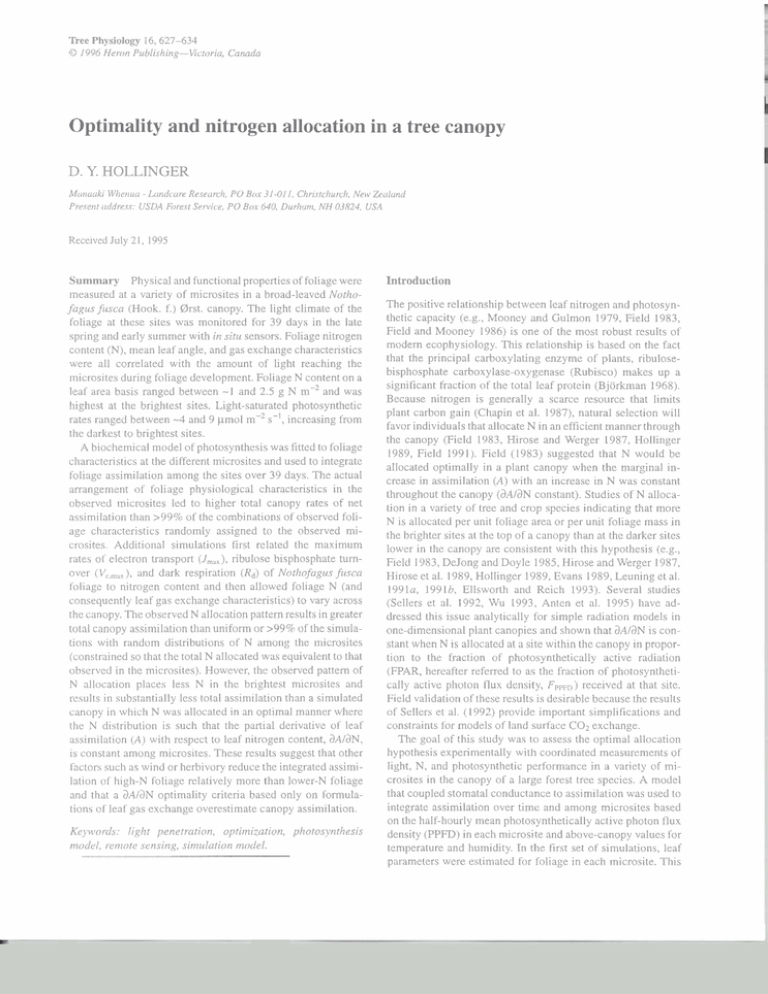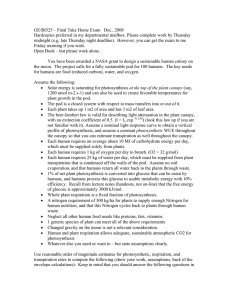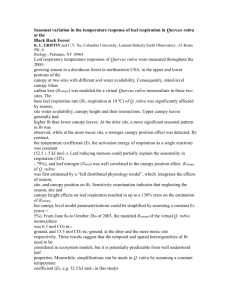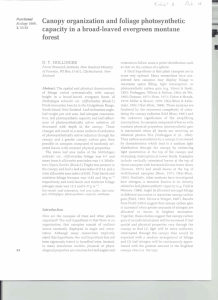Optimality and nitrogen allocation in a tree canopy D. Y. HOLLINGER
advertisement

n e e Physiology 16,627-634 O 1996 Hewn Publishing-Ectoria, Canada Optimality and nitrogen allocation in a tree canopy D. Y. HOLLINGER Mtinuciki Wl~en~cci - Ltuldture Rereurch, PO Box 31-01 1, Chnstclrurc-h. New Zetihnd Preterit cicldrecc USDA Forest Sei7*icetPO BOA640, Durl~orir,NH 03824. USA Recelved July 2 1, 1995 Summary Physical and functional properties of foliage were measured at a variety of microsites in a broad-leaved Notltofag~t.7 jiacn (Hook. f.) @st. canopy. The light climate of the foliage at these sites was monitored for 39 days in the late sprlng and early summer with in sitcl sensors. Foliage nitrogen content (N), mean leaf angle, and gas exchange character~stics were all correlated with the amount of light reaching the micros~tesduring foliage development. Foliage N content on a leaf area basis ranged between - I and 2.5 g N m-2 and was highest at the brightest sites. Light-saturated photosynthetic rates ranged between -4 and 9 pmol m-'s-', increasing from the darkest to brightest sites. A b~ochernicalmodel of photosynthesis was fitted to foliage character~strcsat the different microsites and used to integrate fol~ageassimilation among the sites over 39 days. The actual arrangement of foliage physiological characteristics in the observed rnicrosites led to higher total canopy rates of net of the combinat~onsof observed foliassimilation than ~ 9 9 % age characteristics randomly assigned to the observed microsites Additional simulations first related the maximurn rates ol electron transport (J,,,), ribulose b~sphosphateturnover (V,,,,,,,), and dark respiration (Rd) of Notl~ofURusfuscn foliage to nitrogen content and then allowed fol~ageN (and consequently leaf gas exchange characteristics) to vary across the canopy. The observed N allocation pattern results in greater total canopy assimilat~onthan uniform or>99% of the simulaLions with randorn distributions of N among the microsites (constrained so that the total N allocated was equivalent to that observed in the microsites). However, the observed pattern of N allocation places less N in the brightest m~crositesand results in substantially less total asslmllat~onthan a simulated canopy in w h ~ c hN was allocated in an optlmal manner where the N distribution is such that the partla1 derivative of leaf assim~latlon(A) with respect to leaf nitrogen content, dAIdN, 1s constant among microsltes. These results suggest that other Ihctors such a5 wind or herblvory reduce the integrated assimilation of hlgh-N I'oliage relatively more than lower-N foliage and that a 3AldN optimality criteria based only on formulations of leaf gas exchange overestimate canopy assim~lat~on. Kejw~ords: light penetration, optimization, pl~otosyntkesis inodel, retrlote sensing, sinz~llationtnodel. Introduction The positive relationship between leaf nitrogen and photosynthetic capacity (erg., Mooney and Gulrnon 1979, Field 1983, Fleld and Mooney 1986) is one of the most robust results of modern ecophys~ology.This relationship is based on the fact that the principal carboxylating enzyme of plants, ribulosebisphosphate carboxylase-oxygenase (Rubisco) makes up a significant fraction of the total leaf protein (Bjorkman 1968). Because nitrogen is generally a scarce resource that llmits plant carbon gain (Chapin et al. 1987), natural selection will favor individuals that allocate N In an efficient manner through the canopy (Field 1983, Hirose and Werger 1987, Hollinger 1989, Field 1991). Field (1983) suggested that N would be allocated optimally in a plant canopy when the marginal Increase in assimilation (A) with an Increase m N was constant throughout the canopy (dAIdN constant). Studies of N allocation in a varlety of tree and crop species indicat~ngthat more N is allocated per unit foliage area or per unit follage mass in the brighter sltes at the top of a canopy than at the darker sites lower in the canopy are consistent with this hypothesis (e.g., F~eld1983, DeJong and Doyle 1985, Hirose and Werger 1987, Hirose et al. 1989, Hollinger 1989, Evans 1989, Leuning et al. 199 la, 199 1b, Ellsworth and Reich 1993). Several studies (Sellers et al. 1992, Wu 1993, Anten et al. 1995) have addressed t h ~ sIssue analytically for simple radiation models in one-dimensional plant canopies and shown that dAIdN is constant when N 1s allocated at a site wlthln the canopy In proportion to the fraction of photosynthetically active radiation (FPAR, hereafter referred to as the fract~onof photosynthetically active photon flux density, FppFD) recelved at that s~te. Field validation of these results IS desirable because the results of Sellers et al. (1992) provide important simplifications and constraints for models of land surface C 0 2 exchange. The goal of this study was to assess the optimal allocation hypothesis experimentally with coordinated measurements of light, N, and photosynthetic performance in a variety of microsites in the canopy of a large forest tree species. A model was used to that coupled stomata1 conductance to ass~mllat~on integrate assimilation over time and among microsites based on the half-hourly mean photosynthetically active photon flux density (PPFD) in each microsite and above-canopy values for temperature and humidity. In the first set of simulations, leaf parameters were estimated for foliage in each microsite. T h ~ s






